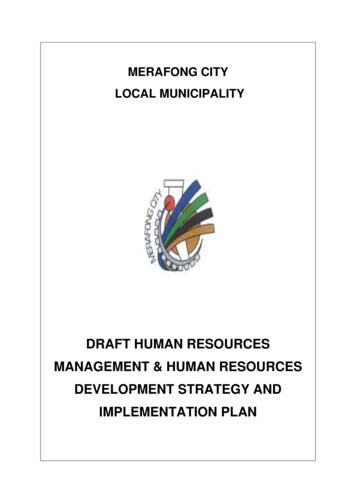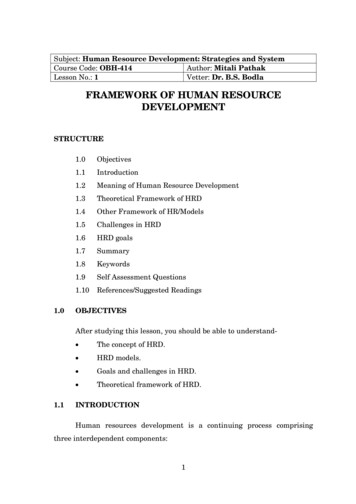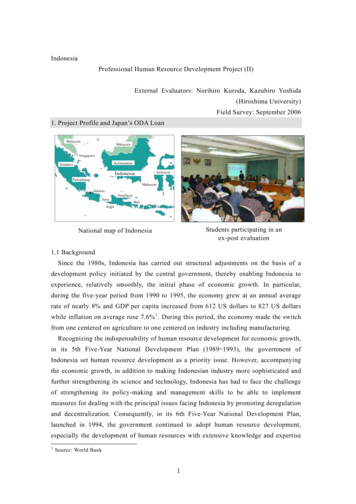
Transcription
IndonesiaProfessional Human Resource Development Project (II)External Evaluators: Norihiro Kuroda, Kazuhiro Yoshida(Hiroshima University)Field Survey: September 20061. Project Profile and Japan’s ODA aliJogjaStudents participating in anex-post evaluationNational map of Indonesia1.1 BackgroundSince the 1980s, Indonesia has carried out structural adjustments on the basis of adevelopment policy initiated by the central government, thereby enabling Indonesia toexperience, relatively smoothly, the initial phase of economic growth. In particular,during the five-year period from 1990 to 1995, the economy grew at an annual averagerate of nearly 8% and GDP per capita increased from 612 US dollars to 827 US dollarswhile inflation on average rose 7.6% 1 . During this period, the economy made the switchfrom one centered on agriculture to one centered on industry including manufacturing.Recognizing the indispensability of human resource development for economic growth,in its 5th Five-Year National Development Plan (1989—1993), the government ofIndonesia set human resource development as a priority issue. However, accompanyingthe economic growth, in addition to making Indonesian industry more sophisticated andfurther strengthening its science and technology, Indonesia has had to face the challengeof strengthening its policy-making and management skills to be able to implementmeasures for dealing with the principal issues facing Indonesia by promoting deregulationand decentralization. Consequently, in its 6th Five-Year National Development Plan,launched in 1994, the government continued to adopt human resource development,especially the development of human resources with extensive knowledge and expertise1Source: World Bank1
in the field of science and technology as well as in policy making and implementation, asone of the main policy issues facing the central government.In Indonesia, the country achieved over 100% as the gross primary school enrolmentratio by 1980. In higher education, which was expected to play a principal role indeveloping professional human resources, school enrollment stood at 540,000 (GER3.8%)as of 1980. But by 1990, it had exceeded 1.7 million (GER9.5%) and by 1995, 2.3 million(GER11.3%). 2 During this period, because of budgetary constraints, the number ofstate-run universities remained relatively constant. 3 Thus, most of the increase in studentenrollment in higher education can be attributed to an increase in the number ofprivately-run higher education institutions. However, since most of the increase had beenat the undergraduate level, the opportunity to enroll in masters and doctoral programs atboth state and private universities remained limited. In addition, while a number ofhigh-quality colleges and universities had been established, the overall quality of highereducation remained so poor that it failed to provide the basis for the human resourcedevelopment policy the government had been promoting. This forced the government toimplement its human resource development policy through the country’s study abroadprogram with the cooperation of international organizations.It is under these circumstances that JBIC has been supporting the government ofIndonesia’s efforts to dispatch students abroad by extending loans to the “Science andTechnology Manpower Development Program (1988–1997)” and the “ProfessionalHuman Resource Development Project (I) (1990–1998).” As the 6th Five-Year NationalDevelopment Plan demonstrates, the government continues to place human resourcedevelopment at the top of its list of priorities, and JBIC, capitalizing on its experience andperformance in assisting programs that support students studying abroad, carried out thisproject with a view to further improving Indonesia’s efforts at human resourcedevelopment.1.2 ObjectiveThe project objective was, continuing from phase I, to nurture human resources withthe extensive knowledge and technical expertise required to play a key role in governmentagencies by providing government personnel with opportunities to study 4 or undergoshort-term training abroad (mainly in Japan) and in Indonesia, thereby contributing to theeconomic growth of Indonesia.2Source: World Bank’s EdStats (web edition)For example, in 1985 there were 30 universities, which were under the supervision of the Ministry ofNational Education, as opposed to 31 in 1995. During the same period, the number of privately-rununiversities rose from 131 to 251.4In this report, “study abroad” and “study in Indonesia” mean to study at academic institutions to obtain BA,MA, MS, or Ph.D. degrees.32
1.3 Borrower/Executing AgencyThe Republic of Indonesia / Three agencies: National Development Planning Agency(BAPPENAS), Ministry of Finance (MOF), and Agency for Assessment and Applicationof Technology (BPPT)1.4 Outline of Loan AgreementLoan Amount / Loan Disbursed AmountExchange Notes / Loan AgreementTerms of Conditions-Interest Rate-Repayment Period (Grace Period)-ProcurementFinal Disbursement DateMain Contractor(Above 1 billion yen per contract)Consultant Services(Above 100 million yen per contract)2. Evaluation Result8.5 billion yen / 6.776 billion yenDecember 1995 / December 1995ConsultantMain2.3%2.5%30 years (10 years)30 years (10 years)Partially untiedGeneral untiedDecember 2004NoneJapan-Indonesia Science and TechnologyForum, etc.(Total Rating: B)2.1 Relevance(Rating : A)2.1.1 Relevance at the time of appraisalContinuing the policy it adopted in the 5th Five-Year National Development Plan(1989—1993), in the 6th Five-Year National Development Plan (REPELITA VI)(1994—1999), the government of Indonesia defined human resource development as amajor policy concern. In particular, Indonesia’s central government agencies regarded astheir priority challenges (i) the development of human resources capable of playing a keyrole in the design and implementation of new policies including those for promotingderegulation and utilizing private sector funds and (ii) the training of researchers in thefield of science and technology. In 1994, in an effort to improve the skills of specialist,technical, and managerial personnel through the effective use of training programs inIndonesia and abroad, the government issued a number of decrees including Decree No.14 (Education and Training of Public Officials), Decree No. 15 (Assignment of PublicOfficials to Structural Positions), and Decree No. 16 (Functional Positions of PublicOfficials). In addition, because of the underdevelopment of institutions of highereducation and training facilities in Indonesia, promoting study abroad programs wereconsidered essential.Understanding the continuing importance of developing human resources as expressedin the 5th and 6th Five-Year National Development Plans, the government of Indonesia3
has been implementing study abroad and study in Indonesia programs, which havereceived support from donors such as the World Bank’s “Science and TechnologyTraining Project” (Ln. 2599) and PHRDP Phase I (Ln. 3134), while JBIC has beenimplementing two study abroad and study in Indonesia projects for governmentpersonnel: “Science and Technology Manpower Development Program (1988–1997)” and“Professional Human Resource Development Projects (I) (1990–1998).” Inheriting theseprograms, this project was to nurture human resources with the extensive knowledge andtechnical expertise required to play a key role in government agencies by providinggovernment personnel opportunities to study and undergo short-term training abroad(mainly in Japan) as well as in Indonesia. As such, the project had a high degree ofpriority.2.1.2 Relevance at the time of evaluationThe Medium-term National Development Plan (PROPENAS) (2000–2004) aimed atrealizing “good governance,” including control of corruption, decentralization, publicsector improvement, and economic deregulation. The current Medium-term NationalDevelopment Plan (RPJM) (2004–2009), which has set as its goal the creation of anefficient government that can fight corruption, has expertise and takes responsibility. Inparticular, RPJM strives to enhance the ability and expertise of civil servants byimplementing a human resource management program in government agencies. 5 Torealize these goals, cultivating administrative officials with highly specialized knowledgeand technical expertise in vital sectors is a task that is increasingly urgent.In its 2007 annual action plan (RKP), RPJM regards bureaucratic reform as a priorityissue and advocates enhancing the ability of civil servants. On the other hand, in additionto promoting economic growth, since the end of the 1990s, the government has initiated aseries of administrative and financial measures to accelerate the process ofdecentralization including the passage of a number of laws in 2004: Medium-termNational Development Plan System Law (Law No. 25), Local Governance Law (Law No.32), and Financial Decentralization Law (Law No. 33). As a consequence, realizingderegulation and decentralization has emerged as a pressing issue for the government. Inmeeting this new challenge, government administrators with extensive knowledge andtechnical expertise remain as important today as ever.To promote the functional improvement of the public sector, including the government,Indonesia has consistently placed importance on developing human resources with highlevels of expertise and has, from the time of appraisal to the present, included human5This program includes reconsidering the scale of civil servants, improvement of the expertise of civilservants, improvement of the quality of education and training of civil servants.4
resource development among its national development plans. The “Professional HumanResource Development Project (III)” (conclusion of an LA in March 2006), the inheritorof this project, is being implemented as an ODA yen-loan project to provide governmentpersonnel opportunities to study abroad and in Indonesia. In that project, the governmentalso continues its program of providing government personnel opportunities to study orundergo training in Indonesia. Given the fact that the individual issues related todecentralization and deregulation have begun to take form, the relevance of this project,which aimed to improve the quality of government personnel by providing them withopportunities to study or undergo short-term training abroad (mainly in Japan) and inIndonesia, continues to be recognized. This is backed up by the comments of respondentsof the beneficiary surveys of the three executing agencies that were conducted as part ofthe evaluation of this project.While many new colleges and universities have been built as Indonesia’s highereducation institutions and training facilities mostly in regional communities, they are stillnot developed enough to meet the new challenges such as the decentralization facingIndonesia today. On the other hand, thanks to the reform of higher education, a number ofinstitutions in Indonesia have developed into high quality colleges and universities. It canbe said that this project, which provided human resource development that combinedstudy and training abroad and in Indonesia, responded to the country’s needs and suitedthe actual conditions.The Asian economic crisis that erupted in the second half of 1997, that is, when thisproject was being implemented, had dire consequences for the Indonesian economy,resulting in the toppling of the Suharto regime that had ruled the country for nearly 30years. The economic crisis caused great damage to the Indonesian economy including aprecipitous drop in the value of the rupiah, a debt servicing crisis, inflation, andunemployment. However, the government took steps to recover from the damage byimproving its ability to govern by, among other things, promoting democratization,wiping out the structure of corruption, and after 2001, transferring to local governments aconsiderable amount of power in making decisions regarding administrative and fiscalmatters. After this project was launched, and as the government came under increasingpressure to deal with the variety of political and economic issues that came to the surfaceas a result of such drastic changes, the importance of developing human resources withextensive knowledge and expertise to be able to contribute to the efforts that were beingmade to deal with such issues gained increasing recognition.2.2 Efficiency (Rating : B)2.2.1 Outputs5
2.2.1.1 Past records of study abroad and trainingUnder this project, a total of 848 students, nearly double the number originally planned(448), were sent abroad or to some area of Indonesia to acquire a college degree. Thenumber of students that were actually sent abroad (524) exceeded the number originallyplanned (308) by about 70%. As is shown in Tables 1 and 2, for all three executingagencies — BAPPENAS, the MOF, and BPPT— the number of students actually sentabroad exceeded the number originally planned. The main reason is that the cost ofsending one student to Japan turned out to be lower than expected. The excess funds wereused to send additional students to study abroad.The number of students who actually studied abroad/in Indonesia for a degreeexceeded the number originally planned (30 40) in the case of undergraduate programs,and (299 700) in the case of master’s programs. Although they were not included in theoriginal plan, BAPPENAS sent 287 of its most promising local administrative officers toareas within Indonesia. For doctoral programs, both BAPPENAS and the MOF dispatchedmore students than they originally planned. In the case of BPPT, the agency discontinuedsending students to areas within Indonesia and instead sent them to Japan within itsbudget by applying the funds made available by the discontinuance. Consequently, as awhole, the total number of students the agency sent for a doctoral program turned out tobe fewer than the number the agency originally planned (119 108), the number ofstudents the agency sent abroad exceeded the number it originally planned to send.Additionally, with the exception of students who were sent to countries other than Japanbecause the courses they wanted to major in were not available in Japan (12 to Australia,6 to the U.S., and 4 to the U.K.) 6 , all the students dispatched to Japan enrolled inJapanese universities and higher education institutions.Table 1: Original Plan of Study Abroad / Training ProgramsBAPPENASMOFOverseas (all in Japan)Degree M.A/7835071M.S.Ph.D.7B.A./672514B.S.M.A/48In IndonesiaDegree ObjectiveNo. .D.B.A./B.S.M.A/003,4000000TotalDegree ObjectiveTotalDegreeno. 14B.S.M.A/Training3,750486As for the destination of overseas students, in the discussion leading up to the conclusion of the loanagreement, as a general rule, Japan was the country where students studied. However, if their needs couldnot be met in Japan, as an exception, they were allowed to study elsewhere. The actual courses that they tookincluded aeronautical engineering, material science, health physics, and information technology. There wasone student dispatched by the MOF and 21 students dispatched by BPPT.625
ble 2: Study Abroad (including Indonesia) / Training 130 4040 1490 2952,130 /BSMA/MSPh.D.000392392012102000143 (1)142 (1)165140 (5)39 (5)1165162390 (16)88 (16)240 (5)39 (5)1700 (1)696 (1)4108 (16)103 (16)5Note: The actual numbers are based on data obtained from the executing agencies at the time of ex-post evaluation.Of the students dispatched by BPPT to Japan, 3 earned bachelor’s degrees, 8 earned master’s degrees, and 4 earneddoctoral degrees with scholarships they obtained from other institutions being sent to study in Japan.Most of the students in doctoral programs who were sent from BAPPENAS majored ineconomics or business administration. Those who enrolled in master’s programs mainlymajored in fields such as international relations, international development, developmentplanning, and development studies. In the case of students who were sent from the MOF,most of the students in doctoral programs majored in economics or businessadministration, while those enrolled in master’s programs majored mainly strativesciences,internationaldevelopment, or international relations), public policy, or the like. Whether on the7Training0No Degree0Total No. of StudentsDegreeObtained0No. of .D.BA/BSMA./MSPh.D.Degree ObtainedTrainingTrainingDegree Obtained00TotalNo DegreeMOFIn MSPh.D.1210BA/B00SMA/131 (1) 130 (1)MSPh.D.65BA/B40 (5)39 (5)SMA/140138MSPh.D. 90 (16) 88 (16)BA/40 (5)39 (5)BSMA/376 (1) 373 (1)MSPh.D. 108 (16) 103 (16)No DegreeNo. of StudentsDegreeObtainedOverseas(in parentheses, other than Japan)Degree Obtained2,412002,412
graduate or undergraduate level, the bulk of the students sent from BPPT majored inengineering technology or in some other scientific fields (Table 3). Although comparisonscannot be made because the number of students that the three executing agencies plannedwere not selected in terms of their majors, it can be said that the majors these studentsactually took corresponded to the areas of expertise associated with each of the threeexecuting agencies that dispatched them.Table 3: Number of Students Who Studied in Japan by otal2733128388916172818502On the other hand, the actual number of trainees (282 abroad, 2,130 in Indonesia) wasfewer than the number originally planned (389 abroad, 3,400 in Indonesia). The numberof personnel who received training in Indonesia decreased significantly becauseBAPPPENAS, the agency in charge of all domestic training programs, changed the planso that most of the training cost (for 2,800 trainees) would be covered by money drawnfrom the government budget and by money borrowed from the World Bank. However, toaddress the issue of decentralization, which was implemented in earnest while this projectwas being implemented, BAPPENAS subsequently expanded the number of participantsin its training program. As a result, from BAPPENAS two thirds of the planned number ofpersonnel actually participated in the training programs in Indonesia. In addition,short-term training abroad was curtailed by all three executing agencies. Indeed, exceptfor the BAPPENAS component, there were no personnel sent abroad for short-termtraining. The reason is that the program did not clearly indicate a favorable cost-to-benefitratio, so that in the middle of the project, the training program was basically shifted todomestic training. Consequently, the number of personnel who actually participated in thetraining program was about 30% less than was originally planned.8
2.2.1.2 Consulting servicesApproximately 10% more hours of consulting services (1,114.5 M/M) were providedthan was originally planned (999 M/M). The main reason is that the one-year extension ofthe period for implementing the project (which will be discussed later) forced acorresponding extension in the number of hours of consulting services that were provided.Table 4 shows the details of the consulting services provided.Table 4: Comparison of Consulting Services at the Time of Planning andActual Services ProvidedTORType ofconsultantAt the of time ofplanning M/M(Employmentexecuting agencyM/M)135M/MOFUTET: 90M/MBPPT: 35M/MActual M/M(Employment executingagency M/M)Operation of trainingInternationalTraining coordinationand financial control ofstudy abroad programLocal522M/MOFUTET: 180M/MMOF: 174M/MBPPT: 168M/M636.5M/MOFUTET: 176.5M/MMOF: 92M/MBPPT: 368M/MStudy abroad supportservice (procedure fordispatching [accepting]students, payment oftuition, allowance,etc.) (EEO)TotalLocal342M/M (EEO)BAPPENAS: 162 M/MMOF: 96 M/MBPPT: 84 M/M388M/M(EEO)BAPPENAS: 186 M/MMOF: 100 M/MBPPT: 102 M/M999 M/M1114.5 M/MInternationalLocal135 M/M864 M/M90M/MOFUTET: 90M/MExplanation and reasons forthe changeSince a local consultantperformed the services onbehalf of BPPT, there is norecord of consulting servicesactually provided by BPPTIn the middle of the project,the MOF canceled the contractit had with a local consultant,after which it implemented itsown coordination andsupervision carried out mainlyby MOF staff members withcounseling experience.Since BPPT strengthened itscoordination service and hadto employ an IT consultant,which was not in the originalplan, M/M increased.Extension of the periodaccompanying the extension ofthe time for implementing theproject.90 M/M1024.5 M/MIn this project, which was implemented by three executing agencies, coordination ofproject implementation was carried out by the coordinating agency OFUTET establishedwithin BAPPENAS. In addition, consultants were hired within the MOF and BPPT toadvise on their respective operations. Moreover, along with the BPPT, a number ofindependent corporations participated in the BPPT component, including the IndonesianNational Nuclear Energy Agency (BATAN), the Indonesian Institute of Sciences (LIPI),and the Central Bureau of Statistics (BPS). Therefore, it was deemed necessary to provide9
far more consulting services than originally planned or to provide IT consulting servicesthat were not included in the original plan. Thus, to reinforce the coordination andsupervision services, in the case of local consultants within BPPT, more than double theamount of time had to be devoted than was planned to provide the required consultingservices.Additionally, in this project, a consultant (EEO) was hired, among other things, to helpstudents decide where they should study and to monitor their activities while in Japan.Because the project period was extended, the term of the contract with EEO was alsoextended.2.2.2 Project periodThe project period at the time of planning was supposed to be from December 1995 toOctober 2003, but actually the project lasted from December 1995 to October 2004 (13%longer than the initial plan). The reasons for the delay are as follows. For BPPT until1998 and for BAPPENAS and for the MOF until 2000, all three executing agenciesachieved their numerical goals for sending students to study abroad or in Indonesia. Afterthat, in response to the progress that had been made in front loading and cutting back onexpenses, the agencies reviewed the budget and the implementation plan and decided toincrease the number of personnel to be dispatched abroad. As a result, the period forproviding consulting services was extended, which in turn delayed the completion of theproject for 12 months from the original plan.2.2.3 Project costThe total cost of the project was significantly reduced. The actual cost was 6.917billion yen against 10.034 billion yen of the original cost, for a reduction of about 30%.As for the ODA yen-loan portion, the actual cost was 6.776 billion yen against 8.5 billionyen of the original cost, which was a reduction of about 20%. There were two reasons forthis. First, the cost involved in overseas study (mostly in Japan) and in training wasreduced (5,614 million yen 5,177 million yen). In terms of cost per student, this meant areduction of 15% to 45%. The reduction was made possible because, despite the fact thatat the time of appraisal most students were expected to attend private universities, whichcharge more tuition than do national and public universities, nearly 70% of the studentsattended national and public universities, and because there was no significant rise inoverseas prices during the project period.The second reason for the reduction is that, with the economic crisis of 1997 as thewatershed event, the Indonesian rupiah lost more than a third of its value, thus drasticallyreducing the cost of the domestic currency against the yen and, combined with the10
reduction of the project cost, the loan amount was scaled down by about 20% from theamount allocated in the original plan.2.3 Effectiveness (Rating: A)2.3.1 Number of participants earning a degree 7Considerably more students earned degrees than were originally expected (Table 5). Atotal of 838 students earned degrees (515 earned theirs abroad) as opposed to 448 who, atthe time of appraisal, were expected to earn degrees (308 were expected to earn theirsabroad). For all three executing agencies, the number of students who earned degrees faroutnumbered the goal set at the time of planning. Only 9 students who studied abroadfailed to earn degrees, and only 1 who studied in Indonesia failed to earn a degree. So therate of degree acquisition was extremely high. The reason is twofold: (i) in Japaneseuniversities, especially in the master’s programs, students rarely withdraw before earningtheir degrees due to failure in their academic performance. Thus the number of studentsearning their degrees under this project is not particularly high; and (ii) the threeexecuting agencies require candidates for study in Japan and other countries to go througha rigorous selection process (BAPPENAS selected only 1 out of 6 candidates, MOFA 1out of 14, and BPPT 1 out of 10), which means that the elite among government personnelin Indonesia were selected to study abroad.Table 5: Number of Students Earning a DegreeBAPPENASMOFBPPTTotalNo. ofStud.117137270524OverseasDegree .5%26598.1%51598.3%Training28200282In IndonesiaDegree ObjectiveNo. 00%252496%32432399.7%Training2,130002,1302.3.2 Personnel affairs for students after they return homeDeveloping countries are often faced with the problem of a brain drain whereby badlyneeded human resources decide not to return home to their posts but to stay in the countrythey were sent to study. In this project, at least in the BAPPENAS and MOF components,there were no such examples. The one doctoral student dispatched by the MOF shown inTable 6 did not return home to his post because he died before completing his course. Ifthis case were excluded, the return rate would be 100%.7Meanwhile, those who participated in short-term training programs presumably did not aim for a degree;instead all completed the training course.11
Most of the participants in the BAPPENAS and the MOF were personnel with collegedegree when the project started. So when they returned home after completing theirgraduate courses (either master’s or doctorate) in a foreign country or in Indonesia, theyresumed working at the posts they held before they were dispatched and advancedthrough the position classification scheme for college graduates. Incidentally, there havebeen reports that at the MOF those with degrees have an advantage in their careerdevelopment.Even in the case of participants from BPPT, since most of those who were sent to studyabroad and in Indonesia were hired as high school graduates, 8 when they returned home,although the degree would assist them to earn points for promotion, they still resumedwork at the same rank they held when they were dispatched and advanced through theposition classification scheme for high school graduates. In other words, as is the casewith personnel of BAPPENAS and the MOF with college degrees, even if personnel ofBPPT with high school diplomas earned doctorates, under this project, there would be agap in the position classification scheme between these two groups of participants afterthey returned home. Furthermore, there were many cases where, upon returning home,participants in this project were assigned to areas of expertise in which they had noprevious experience. Also, there were reports that the agencies that dispatched thepersonnel abroad under this project failed to provide an environment where thosereturning participants could continue engaging in their graduate level research activities.In many cases, these negative factors combined to force participants to quit their posts orcontinue to remain at their posts only in appearance while actually doing work other thanthat which their positions required them to do.However, in BAPPENAS, the MOF, and BPPT alike, it is possible for personnel to bepromoted, say, to a managerial position under a system of promotion other than theposition classification scheme based on their educational backgrounds at the time theywere hired by these agencies. Thus it is possible for graduates of the project to raise theirskills and expertise and improve their job performance by studying abroad and inIndonesia, which in turn will contribute to their career development.Meanwhile, students studying with public funds are required to work at their agenciesfor a period of twice the time they spend studying plus one year. There is a rule whichstates that if they fail to meet this requirement, they will be forced to pay a penalty. Up tonow, there have been only a few cases of violation of this rule, although the actual amountof penalty paid has not been reported.8At that time, BPPT adopted a human resource development strategy whereby BPPT hired pro
the extensive knowledge and techni cal expertise required to play a key role in government agencies by providing government personnel with opportunities to study4 or undergo short-term training abroad (mainly in Japan) and in Indonesia, thereby contributing to the economic growth of Indonesia. 2 Source: World Bank's EdStats (web edition)
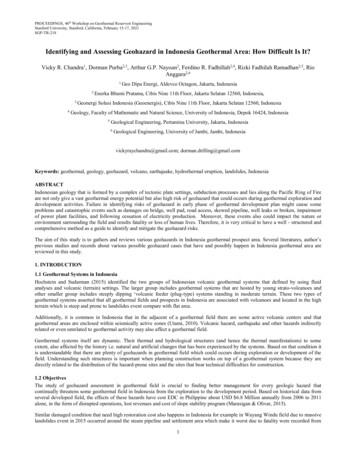

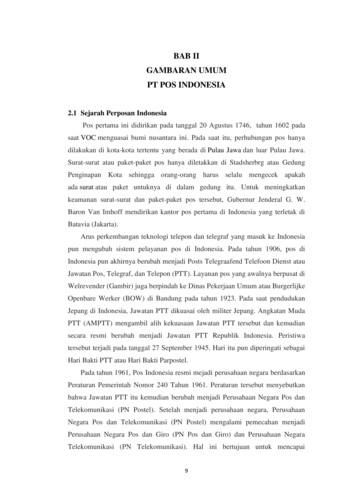

![JMK-nas-8a- [20-1-2018] revision Purwanto - Universitas WR Supratman](/img/15/cekplagiasi-plagiasi-20marketing-20politik.jpg)

